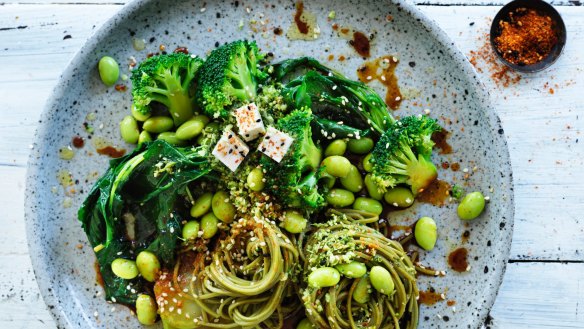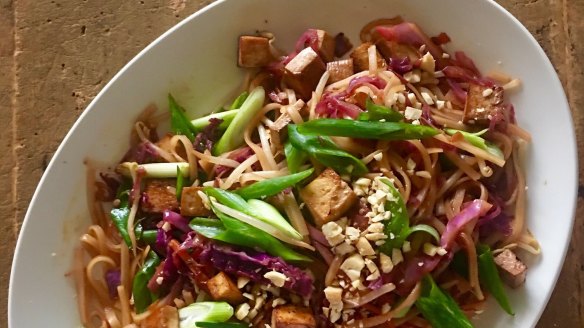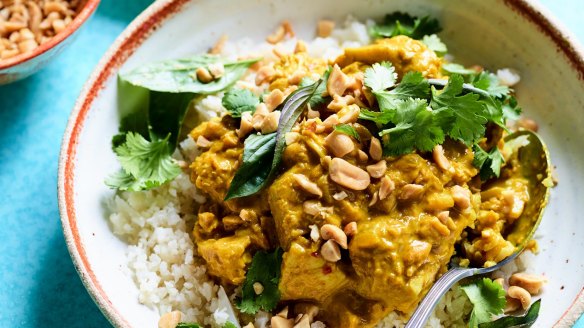How to go vegan naturally with unprocessed plant-based foods

Whether it's due to growing health awareness, curiosity about climate-friendly diets or concern for animal welfare, the trend towards plant-based eating is showing no signs of waning.
Over the past five years, the volume of searches for vegan recipes on Google has roughly doubled in Australia.
And as more people switch to a meat-free diet, a wave of products is emerging to cater to them. From vegan pizzas to plant-based burgers, the meat-free crowd now enjoys a wider range of food options than ever.
But are these processed meat alternatives really necessary when going vegan? Sydney nutritionist Zoe Dent says natural foods such as chickpeas and other legumes tend to be healthier than manufactured "fake meats", which can be low in nutrients and high in sodium, sugar, additives and saturated fats.
"If you're eating mainly processed foods, then you're getting lots of empty calories, calories that come with few or no nutrients," she says.
"The result? Overeating and weight gain as your body remains hungry, demanding the nutrients it desperately needs."
Dent, who works with Amazonia foods to promote their Tender Jack jackfruit products, says a healthy plant-based diet is rich in fibre, vitamins and minerals and has been linked to health benefits such as reduced risk of heart disease, cancer, obesity and diabetes.
"If the focus of your meals is a variety of unprocessed vegetables, fruits, legumes and grains then you may experience more energy, better sleep and brighter skin," she says.
If you're new to meat-free diets, Dent suggests consulting a health practitioner to help you devise a balanced eating plan rich in iron, calcium, essential fatty acids and B vitamins, while low in carb-heavy processed foods.
"Essentially the simplest rule is to aim for five cups of vegetables a day – three cups 'above the ground' such as green leafy vegetables and two cups 'below the ground' such as root vegetables," she says.
"Then ensure you are eating a healthy fat source with every meal, such as avocado, nut butter, olive oil or tahini dressing to ensure you are absorbing the vitamins ADEK in your meal – fat-soluble vitamins which, as the name highlights, need fat for absorption."
"Top your meal with a protein source – ideally combining legumes and grains to ensure you obtain all the essential amino acids – that is, adding lentils and rice, beans and seeds or tempeh with quinoa."

Here, Dent shares food groups that are naturally vegan.
Vegetables should make up the majority of our diets as they are rich in antioxidants, vitamins and minerals, high in fibre and are also the least energy dense, Dent says. "By eating more plants you can naturally consume less calories, which is beneficial to those who are looking to maintain a healthy weight." Vegetables can also be a great source of pre- and probiotics. "Adding garlic, leeks and onions to winter stews enhances its prebiotic effects, whilst fermenting vegetables such as cabbage and carrot will provide gut-healthy probiotics," Dent says.
Legumes are an important source of fibre, protein, carbohydrates and B vitamins for plant-based diets, Dent says. "They can also be a good source of iron, copper, magnesium, manganese, zinc, and phosphorous." For proper digestion, legumes tend to need rinsing and soaking overnight to deactivate anti-nutrients such as phytates and tannins, which reduce nutrient availability.
Nuts and seeds are a great source of protein, healthy fats, vitamins and minerals such as magnesium and zinc, Dent says. It's important to include these in most plant-based meals so your body can digest fat-soluble vitamins in your food, which help nourish your cells and skin, balance your hormones and reduce inflammation. "Flaxseed, chia seeds and walnuts are an especially good choice for plant-based diets as they are rich in essential omega 3 fatty acids, which are anti-inflammatory fats your body can't produce and therefore you need to obtain them from dietary sources," she says.
Whole pieces of fruit are high in fibre and rich in a variety of antioxidants, vitamins and minerals, Dent says. "[But] stay clear of processed fruit juices or calorie-laden fruit smoothies … as they tend to deliver a huge hit of sugar without the fibre." Jackfruit is particularly useful as a natural low-fat, fibre-rich vegan food without the heavy processing of other meat alternatives, Dent says. While you can eat it fresh, ready-to-cook jackfruit flesh is usually sold in packets or cans. "Tender, young jackfruit has a very subtle taste when plain, making it perfect to add as a plant-based alternative into your favourite savoury dishes and cooking with a variety of herbs, spices and sauces."

Creamy jackfruit curry with cauliflower rice recipe
To serve: 4
INGREDIENTS
Curry
- 1 tablespoon coconut oil
- 1 onion, diced
- 800g pulled jackfruit, drained and rinsed (for example, Original Amazonia Tender Jack)
- 400ml canned coconut milk
- 125ml (½ cup) vegetable stock
- 2 fresh or dried bay leaves
- zest and juice of 1 lime
- 80g (½ cup) roasted peanuts, roughly chopped
- 1 handful of Thai basil leaves
- 1 small handful of coriander leaves
- 800g (4 cups) cauliflower rice, optional (See note)
Curry paste
- 5cm piece of ginger, peeled
- 2 garlic cloves, very finely chopped
- 2 teaspoons ground turmeric
- 1 bird's eye chilli or ½ teaspoon chilli flakes
- 1 teaspoon mustard seeds
- 1 teaspoon fennel seeds
- 1 teaspoon fenugreek seeds (optional)
- ½ teaspoon sea salt
METHOD
- To make the curry paste, pound all the ingredients together with a mortar and pestle, or pulse together briefly in a food processor to form a paste.
- Melt the coconut oil in a large saucepan over medium-high heat. Add the onion and cook for 3 minutes, or until softened and caramelised, then stir in the prepared spice paste and cook, stirring, for 2-3 minutes, or until fragrant.
- Pour the coconut milk and vegetable stock into the pan and stir in the jackfruit and bay leaves. Bring to the boil, then reduce the heat to a simmer and leave to cook, uncovered and stirring occasionally, for 30 minutes, or until the curry has reduced. Stir in the lime zest and juice and half the peanuts, then remove from the heat. Taste and add a little salt if necessary.
- To serve, divide the curry among plates and scatter over the basil, coriander and the remaining peanuts. Enjoy with cauliflower rice, if you like.
Recipe by Australian cookbook author and Amazonia ambassador Luke Hines
Note: To make cauliflower rice, whiz florets in a food processor until they look like rice or couscous, then gently pan-fry, steam or blanch.
The best recipes from Australia's leading chefs straight to your inbox.
Sign up